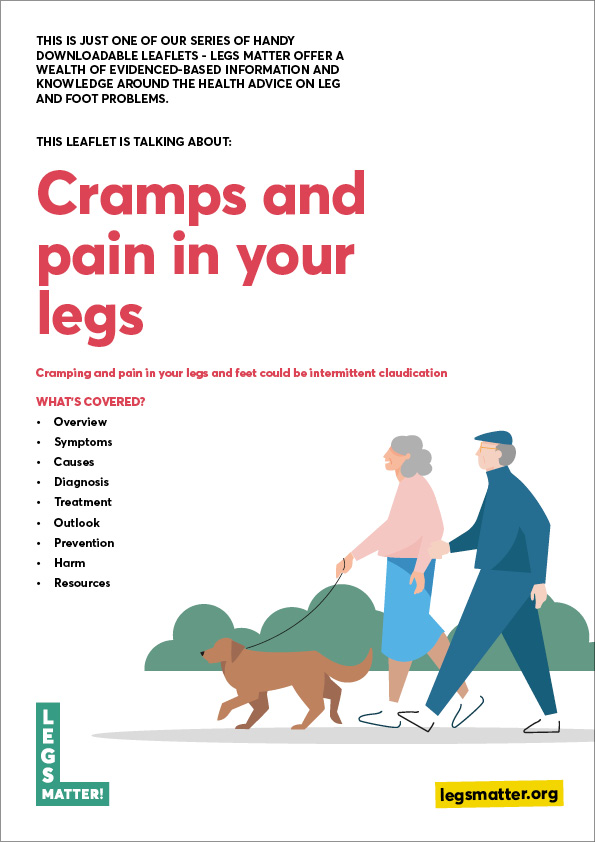Overview – what is cramping and pain in your legs?
We all get leg cramp from time to time. But if you get a cramp in your legs and / or buttocks when you’re walking or exercising that stops after you rest for a while, you could have intermittent claudication. Intermittent claudication is likely to be caused by peripheral arterial insufficiency (PAD).
Symptoms of leg cramps
Intermittent claudication or cramp, is one of the most common symptoms of cardiovascular disease peripheral arterial disease.
If you have lower limb PAD, the blood vessels (arteries) that carry blood to the legs and feet can harden, narrow or get blocked by a build-up of fatty deposits. This reduces the amount of oxygen that can get to your leg’s muscles. When you walk, the leg muscles need more oxygen than when you are at rest. So, if your leg muscles don’t get enough oxygen when moving, they start to hurt or ‘cramp’.
The pain can range from mild to severe and usually goes away after a few minutes when you rest your legs. It is often worse when walking up an incline.
You might feel pain in one leg or in both legs and it might be worse on one side than it is on the other.

Other symptoms of peripheral arterial disease can include:
- Hair loss on your legs and feet
- Numbness or weakness in the legs
- Brittle, slow-growing toenails
- Ulcers (open sores) on your feet and legs that don’t heal
- Changing skin colour on your legs, such as turning pale or blue
- Shiny skin
- In men, erectile dysfunction
- The muscles in your legs shrinking (wasting)
The symptoms of peripheral arterial disease often develop slowly and over time. If your symptoms develop quickly or suddenly get worse, it could be a sign of a serious problem that needs immediate treatment.
If you have peripheral arterial disease in your legs and feet, it can be a sign that you are at risk of other cardiovascular problems, such as angina, heart attack or a stroke. This is because if the arteries in your legs and feet are narrowed or blocked by fatty deposits, blood vessels elsewhere in your body are likely to be affected too.
Causes – what can cause cramp in the legs?
Legs cramps can happen for a variety of reasons. But are defined as a pain in the muscles when the muscles tighten causing it to become difficult to move and painful.
It can sometimes be caused by dehydration or exercise. If there is a pattern that the pain occurs on exertion such as walking and goes away at rest then you should make an appointment to see your GP or Nurse.
Diagnosis – cramps and peripheral arterial disease
Many people mistakenly think this pain is just part of growing older, but there’s no reason why an otherwise healthy person should experience cramping leg pain when exercising. If you are getting recurring painful cramps in your lower legs when walking, make an appointment at your GP practice. You may be given an appointment to see the nurse or podiatrist rather than the doctor as nurses and podiatrists are often responsible for caring for patients with leg and foot problems.
Remember to remove any nail polish from your toenails before your appointment.
When you see the nurse, podiatrist or doctor, they should:
- Ask about the presence and severity of possible symptoms of intermittent claudication and critical limb threatening ischaemia
- Examine the legs and feet for evidence of critical limb threatening ischaemia, for example ulceration
- Examine the femoral, popliteal and foot pulses
- Measure the ankle brachial pressure index), and they may also record your toe brachial pressure index (TBPI)
Measuring of the ankle brachial pressure index (ABPI) should be done in the following way:
- You should be rested and supine if possible
- The systolic blood pressure will be recorded with an appropriately sized cuff in both arms and in the posterior tibial, dorsalis pedis and, where possible, peroneal arteries
- Measurements should be taken manually using a Doppler probe of suitable frequency in preference to an automated system
You might also be offered some more tests to rule out other health problems that can affect your legs, including diabetes, anaemia, thyroid and kidney problems, and cholesterol problems.
If your healthcare professional thinks you have problems with your arteries, they might refer you for further tests at your local hospital or specialist clinic.
Treatment – what treatment will I be offered for leg cramps?
Atherosclerosis doesn’t just affect the arteries in your leg, but also arteries to your heart and to your brain. This can cause heart attacks or strokes. The most important part of the treatment for claudication is making sure that the disease doesn’t progress further or spread to other arteries. The best way of doing this is by making changes to your lifestyle.
- Smoking cessation
- Diet, weight management and exercise
- Lipid modification and statin therapy
- The prevention, diagnosis and management of diabetes
- The prevention, diagnosis and management of high blood pressure
- Antiplatelet therapy
Medication
Your healthcare practitioner should offer you a blood thinner, such as clopidogrel, and a statin, such as atorvastatin, to lower your cholesterol. These medications should not only help reduce the cramp in your legs but help reduce the chance of major cardiovascular problems such as heart attacks or strokes.
If you have diabetes or high blood pressure (hypertension) it is important that these are well-controlled through medication if necessary.
Exercise
Your healthcare practitioner will talk to you about the importance of adopting a healthy lifestyle. This will include the importance of stopping smoking, maintaining a healthy weight and the importance of exercise. Exercise in itself can be a treatment for cramp, as overtime this can improve your pain-free walking distance. This should be the first recommended treatment, before surgery is considered.
The ideal is to join a supervised exercise programme, where you will be offered 2 hours of supervised exercise over a 3-month period. If supervised exercise programmes are not available in your area you may be asked to undertake a period (3 months) of structured exercise exercising for at least 2 hours a week, where you will be encouraged to exercise to the point of maximal pain, wherever possible. As exercise is good for cramping and your general health it’s important that this is undertaken before considering any form of surgery.
Further treatment
If leg cramp is having a big impact on your quality of life, you might want to consider surgery. Sometimes a narrowing or blockage in your artery can be opened up and stretched using a small balloon. This procedure is done under a local anaesthetic in the radiology department of hospital.
If your symptoms are very severe and the blockage is too big to open up with a balloon, a bypass operation might be an option. This is where a vein from your leg or an artificial artery is used to carry the blood past the blockage. Your vascular specialist will talk through all these options with you.
Outlook for leg cramps / intermittent claudication
Most people with Intermittent claudication will remian stable. Approximatley 5-10% of those with claudication will go on to develop critical limb threatening ischaemia, which is the most severe form of peripheral arterial disease.
Prevention – how can I prevent leg cramp / intermittent claudication?
Making healthy changes to your lifestyle can help reduce or stabilise claudication and stop it turning into something more serious:
- Maintain a healthy weight. If you are overweight, losing weight will help your arteries and mean you can walk further.
- Take light to moderate exercise such as swimming or walking for about 30 minutes at least three times a week. Exercise forces our blood vessels to form new branches and improves the blood circulation in our legs. Don’t worry if your legs hurt a little when you exercise, but exercise should not make you feel unwell.
- Stop smoking. Smoking increases the hardening of the arteries by about ten times. It also makes the smaller arteries close up. It is hard to quit, but there’s lots of support to be found through your nurse or doctor, including Nicotine Replacement Therapy. Here are some links which you may find to be useful
Harm – the risk factors
- It’s important that Primary Care ensures that patients with intermitten claudication are on best medical management and are taking a high dose statin and antiplatelet
- All patients should be offered access to a National Exercise Referral Scheme or their local claudication exercise clinic
Resources – dedicated for leg cramping
Clinical guidelines for peripheral arterial disease
These guidelines give you a useful overview and more detailed information on peripheral arterial disease and diabetic feet:
Peripheral Arterial Disease Diagnosis and management (NICE 2012)
Exercise leaflets in multi languages from the Circulation Foundation
Cramps and pain in your legs downloadable leaflet (PDF)
We’ve created a handy downloadable leaflet of the key information on this page so you can easily print it out for personal reference or to hand to a patient or healthcare professional. Or you can also simply forward it on by email.
Other support
British Heart Foundation The British Heart Foundation were founded in 1961 by a group of medical professionals wanting to fund extra research into the causes, diagnosis, treatment and prevention of heart and circulatory disease. Today they are the nation's heart charity and the largest independent funder of cardiovascular research.
Contact details
0300 330 3322
supporterservices@bhf.org.uk
Find out more on the British Heart Foundation website
The Circulation Foundation The Circulation Foundation is the UK’s only dedicated vascular charity. They fund and promote research into the causes, treatment and prevention of vascular disease.
Contact details
020 7205 7151
info@circulationfoundation.org.uk
Find out more on The Circulation Foundation website
NHS Choices the official NHS website, which provides vital information and support about leg and foot signs and other symptoms.
Contact details
Call 111 - for non-emergency medical advice
Find out more on the NHS Choices website
Tell us what you think
If there’s anything you want to ask us or tell us, whether it’s a suggestion about our website, a complaint, or a compliment, drop us a line at
support@legsmatter.org










